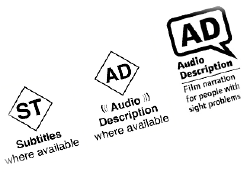An article from cinemabusiness magazine, August 2008; Comment Section by Phil Clapp, chief executive of the CEA (the cinema exhibitors’ association fo the UK) www.cinemaul.org.uk
But the return for the cinema industry — and the reasons behind this activity — perhaps demand deeper analysis. By “the cinema industry” I mean of course not just the exhibition sector, but also distribution colleagues, who have an admirable record in the timely supply of accessible versions of current releases, and those working on the technical and operational aspects of providing such materials, who have been unfailingly positive and constructive in supporting this activity.
The 1995 Disability Discrimination Act (and subsequent revisions) required cinemas to make ‘reasonable adjustments’ to meet the needs of people with disabilities. This undoubtedly focussed minds on the barriers — physical and otherwise — facing disabled people wishing to go to the cinema. The guidelines produced by the Cinema Exhibitors’ Association (CEA) on best practice in this area bear testimony to that.
But the level of investment in which in truth provides a basic framework for action. The industry has embraced the necessary change of mindset more willingly and proactively than many other comparable leisure sectors.
There may, of course, be potential business benefits to such activity, not least opportunities to attract a new and significant audience. There are around two million blind and partially sighted people and around nine million deaf and hard-of-hearing people (including 35,000 children and young people) in the UK — a potential source of genuinely new business at a time when annual cinema admissions remain stubbornly around the 170 million mark. Against that, the evidence is that subtitled screenings for example remain a challenging exercise, with some circuits observing a significant reduction in box office. The reasons for this — usually paraphrased as ‘people dislike subtitles’ — are likely to be complex. (The CEA is currently undertaking a survey with audiences at key circuits to explore this further).
The increased provision of accessible screenings can only of course help the public image of cinema. Experience suggests that in any dispute between a cinema operator and a disabled customer, there is only one winner in the court of local public opinion. But current levels of co-operation and engagement provided by groups representing people with sight and hearing disabilities seem to be about something other than the wish to ‘name and shame’, and it is for me that shared approach which has been key to the progress made.
Those representative groups, all members of the Industry Disability Working Group, are unfailingly supportive in their approach. Of course they press for more to be done, and offer a robust challenge when things occasionally fall below the standards that have now been set. But they also recognise that the industry has itself been proactive in embracing many of the changes needed to make cinema more accessible to people with disabilities.
Examples of that proactive approach include the willingness of the industry to help fund yourlocalcinema.com, a unique resource which publicises and plots the progress of subtitled and audio described screenings, and to which grateful thanks are due for the charts included in this article. A mention here also for Artsline — www.artsline.org.uk — another organisation which has benefited from cinema industry funding, providing a comprehensive database of the access features of cinemas across the UK.
And while no system is perfect, the introduction of the CEA Card across the vast majority of UK cinemas has brought much needed clarity to the plethora of concessionary and discounted tickets previously on offer to help support disabled people during their trip to the cinema (for more information go to www.ceacard.co.uk).
There is, of course, no room for complacency. Perhaps stoked by the pace of recent improvements, the expectations of the public — disabled and otherwise — around levels of service provided by cinemas grow ever higher. But I remain hopeful that while a shared willingness to tackle the sometimes difficult and always sensitive issues around disability prevails, progress will continue. It is a positive story which the whole industry should be proud of and would do well to promote.
A CEA article, updated 10 April 2008 that covers the same ground but with additional points:
disability and access – Cinema Exhibitors’ Association
Text of the UK Disability Discrimination Act 1995 with revisions:
Disability Discrimination Act 1995
